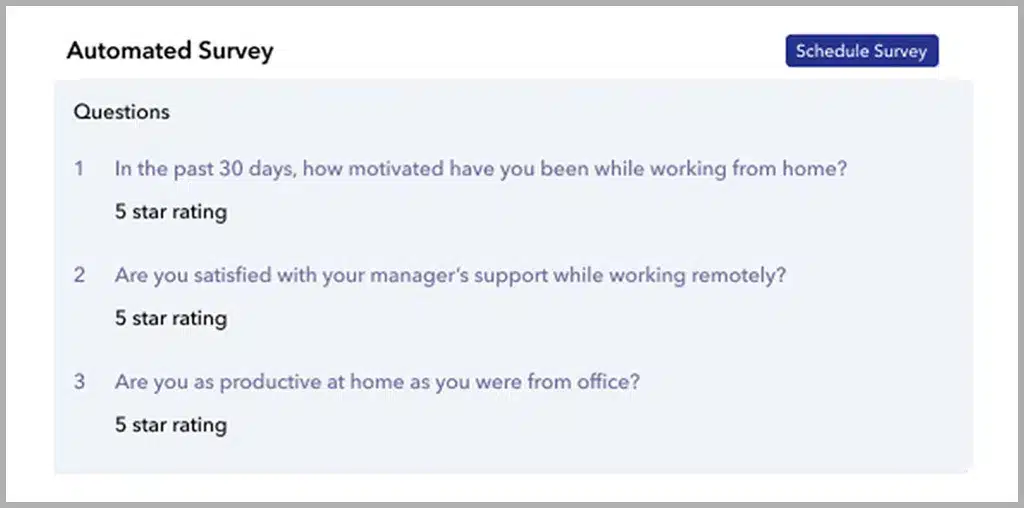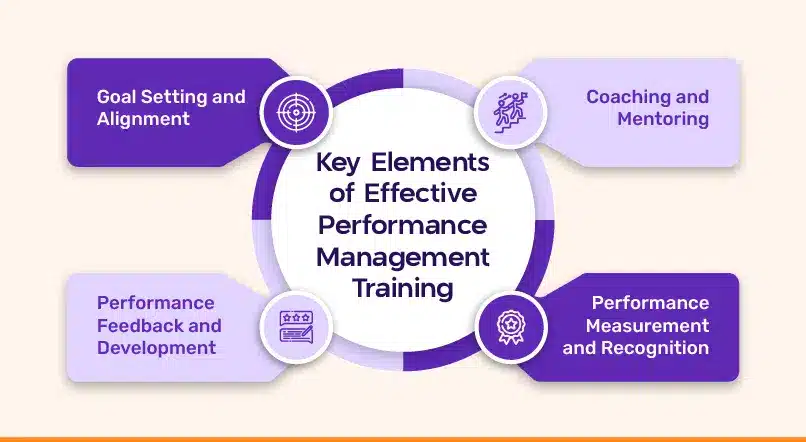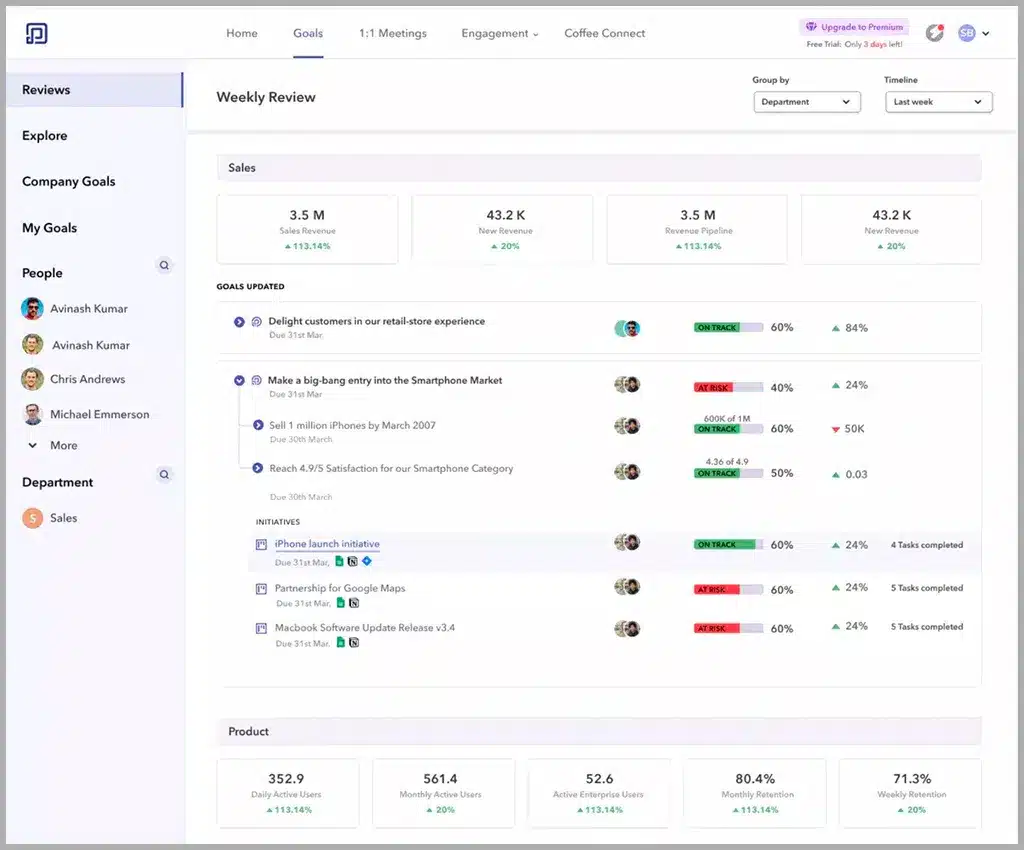Performance management often gets a bad rap: endless paperwork, awkward conversations, and the dreaded annual review. But in reality, it’s a game-changer when done right. A well-structured performance management system can transform your organization into a powerhouse of motivated and high-performing employees.
So, how do you ensure your team understands and embraces this vital process?
The key? Effective performance management training.
In this blog post, we discuss how effective training unlocks motivated, high-performing individuals and drive organizational success. Read along!

What is Performance Management Training?
Performance management training is a structured educational process aimed at equipping employees with the necessary skills and techniques to effectively manage and improve performance within an organization. It covers aspects such as goal setting, feedback delivery, performance appraisal methods, and employee professional development strategies.
With the right training, employees learn how to:
- Set clear, measurable goals aligned with business objectives.
- Deliver and receive feedback that fosters growth.
- Conduct meaningful performance reviews.
- Create a culture of accountability and continuous improvement.
Why is Performance Management Training Important?
Performance management training holds significance for both employees and organizations, playing a crucial role in fostering individual growth and organizational success.
Let’s take the example of Annie, a marketing executive in a fast-paced agency. She’s talented and passionate about her work, but she often feels lost, unsure of expectations and frustrated by sporadic feedback. Without structured performance management, Annie struggles to align her efforts with company goals, leading to disengagement.
For employees like Annie, performance management training offers several benefits:
Clarity and Direction
Training in performance management provides employees with clear expectations and objectives, helping them understand what is expected of them in their roles. This clarity enables employees to focus their efforts on tasks that align with organizational priorities.
Feedback and Recognition
Proper training equips employees with the skills to give and receive feedback effectively. Constructive feedback helps employees identify areas for improvement and recognize their accomplishments, fostering a sense of accomplishment and motivation.
Skill Development
Performance management training often includes opportunities for skill development and growth. Employees learn to identify their strengths and weaknesses, allowing them to take proactive steps to enhance their skills and further their careers.
Increased Engagement
When employees receive regular feedback and feel supported in their development, they are more likely to be engaged and committed to their work. Performance management training fosters a culture of accountability and empowerment, leading to higher levels of employee satisfaction and retention.
With Performance Management tools like Peoplebox.ai, you can send automated engagement surveys to assess employee satisfaction and gather feedback on various aspects of the performance management process.

It must be noted that effective performance management training is essential not just for the employees, but also for the organization.
Now let’s consider the impact of performance management training from an organizational perspective:
Poor Performance Alignment
Without clear performance expectations and goals, employees may struggle to align their efforts with organizational priorities..This misalignment can throw a wrench into strategic objectives, making it harder for the company to achieve success.
Decreased Productivity
In the absence of effective performance management processes, employees may not receive timely feedback or guidance on their performance. This can lead to inefficiencies, missed deadlines, and decreased productivity across the organization.
Low Employee Morale
When employees feel uncertain about their performance or lack opportunities for growth and development, morale can suffer. This can result in higher turnover rates, increased absenteeism, and a negative impact on the overall workplace culture.
Missed Opportunities for Improvement
Managers who aren’t equipped with proper performance management training may struggle to recognize and address performance issues proactively. This means employees aren’t reaching their full potential, and the organization misses out on valuable opportunities for innovation and improvement.
By investing in training programs that empower individuals to excel in performance management, organizations can create a culture of continuous improvement and achieve their strategic goals effectively.
Different Types and Examples of Performance Management Training
Performance management training isn’t a one-size-fits-all approach. To effectively equip employees with the necessary skills and knowledge, you need to tailor the training to their specific needs and roles within the organization.
Here are some different types and examples of performance management training you can consider:
Foundational Training: Building the Basics
This type of training is ideal for new employees or those unfamiliar with the organization’s performance management system. It covers the basics such as:
The performance management process
This includes setting goals, receiving feedback, conducting reviews, and development opportunities.
Setting OKRs
Teaching employees how to craft effective goals that align with the organization’s goals.

Understanding Performance reviews
Breaking down their purpose, expectations, and how to use understanding performance reviews for professional growth
Example: A half-day interactive workshop featuring exercises and role-playing to familiarize employees with the organization’s performance management framework.
Skill-Specific Training: Mastering Key Abilities
This type of training focuses on developing specific skills needed for effective performance management, such as:
Giving and receiving feedback
Developing the ability to provide constructive, actionable feedback while also receiving it with an open mind.

Self-assessment
This helps employees reflect on their performance and identify areas for improvement through Self-assessment.
Example: A two-hour session on providing effective feedback, with case studies and practice opportunities.
Role-Based Training: Tailoring Learning to Different Positions
Not all employees need the same training. Role-based programs ensure that learning is relevant and impactful.
Manager training
This focuses on how to conduct effective performance reviews, provide coaching and feedback, and support employee development.
Employee training
This focuses on understanding performance expectations, setting goals, and communicating effectively with managers.
Example:A full-day training program for managers covering performance review best practices, performance coaching techniques, and development strategies.
Technology-Based Training:Learning Anytime, Anywhere
In today’s digital age, performance management training can be interactive and accessible on demand. Options include:
E-learning modules
These provide interactive learning experiences on various performance management topics( Like LinkedIn Learning).
Microlearning videos
Short, bite-sized videos on specific skills like giving feedback or setting goals.
Simulations and games
Hands-on digital experiences to practice real-world scenarios in a risk-free environment.
Example: A series of performance management training courses accessible on-demand through the company learning management system.
With Peoplebox.ai, you receive premium access to white-glove coaching services, featuring a personalized coaching plan tailored to your needs for mastering and utilizing the software. This includes regular one-on-one coaching sessions with a dedicated coach, ensuring comprehensive support and guidance throughout your journey.
The best performance management training is the one that resonates with your employees and aligns with your company’s needs. By investing in the right training approach, you empower employees to take ownership of their performance and drive organizational success.
Key Elements of Effective Performance Management Training
Performance management training isn’t just another corporate requirement; it’s the key to unlocking your employees’ true potential and fueling organizational success. But what makes training truly effective? Here are the essential elements that will transform your program:

Goal Setting and Alignment:
From siloed aspirations to shared vision
Help employees understand how their individual goals contribute to the bigger picture. Align them with departmental and organizational objectives, fostering a sense of purpose and collaboration.
With Peoplebox.ai, employees gain a clear view of how their work ties into broader organizational goals ensuring alignment and motivation at every level.

Using Proven Goal-Setting Frameworks
Introduce effective goal-setting frameworks like OKRs, equipping employees to craft clear, measurable, and achievable objectives that drive results.
To make it easier for you to help your employees with OKRs, we have created the ultimate OKR cheat sheet you can share with them today!
Performance Feedback and Development:
Feedback as fuel, not fearFeedback That Drives Growth
Teach managers how to deliver timely, actionable feedback focused on specific behaviors and improvement strategies.
Conversations that count
Equip managers with skills to conduct effective performance conversations, fostering open dialogue, clear expectations, and mutual understanding.
Development plans
Move beyond generic training by teaching managers to create individualized development plans tailored to each employee’s strengths, weaknesses, and career aspirations.
Beyond one-on-one
Explore various feedback methods like surveys and 360-degree feedback to gather diverse perspectives and provide a holistic view of performance.

Coaching and Mentoring:
Develop Stronger Manager-Employee Relationship
Train managers to cultivate strong relationships with their teams, built on trust, open communication, and a genuine desire to see them succeed.
Ongoing Coaching, Not Just Annual Reviews
Equip managers with coaching skills to provide continuous guidance and support, helping employees overcome challenges and reach their full potential.
Effective Mentorship Programs
Implement effective mentoring programs that connect seasoned professionals with newer employees, fostering knowledge transfer, career guidance, and a sense of belonging.
Performance Measurement and Recognition:
Metrics that matter
Ensure performance metrics are fair, objective, and aligned with organizational goals. Avoid subjective measures that hinder motivation and clarity.
Performance Measurement platforms like Peoplebox.ai let you measure KPIs against targets to ensure your decisions are always aligned with the goals.
Celebrate success, big and small
Recognize and reward high performance through incentives, awards, and public acknowledgement. Celebrate individual and team achievements to boost morale and motivation.
Performance Management Training For Managers
Great managers don’t just oversee work they coach, inspire, and drive performance. Here’s how effective training helps them do that:
✅ Master Coaching Skills – Teach managers how to support employee growth through active listening, clear communication, and motivation techniques. Role-playing exercises make learning practical and engaging.
✅ Conduct Effective Performance Reviews – Equip managers with the skills to set clear expectations, use objective metrics, and deliver feedback that drives real improvement. Interactive workshops and case studies help them gain confidence.
✅ Handle Difficult Conversations – Address the often-dreaded task of managing underperforming employees. Train managers on conducting difficult conversations, outlining corrective action plans, and providing fair and firm guidance. Include simulations and expert-led discussions to navigate these sensitive situations effectively.
Performance Management Training For Employees
Effective performance management isn’t just about managers; it’s also crucial for employees. Here’s how training empowers employees to take control of their performance:
✅ Set Meaningful Goals –Empower employees to set OKRs aligned with team and organizational objectives. Interactive workshops guide them through crafting meaningful, measurable, and achievable objectives that drive their performance.
✅ Receive & Apply Feedback Effectively –Develop their ability to receive and respond to feedback effectively. Teach them how to interpret and utilize feedback for growth, ask clarifying questions, and demonstrate their commitment to improvement. Group discussions and practice sessions build confidence and receptivity.
✅ Take Ownership of Their Growth –Foster a sense of ownership for performance improvement. Train employees on self-assessment techniques, identifying areas for development, and proactively seeking resources and support. Encourage them to be active participants in their growth journey through interactive exercises and self-reflection prompts.
Conducting Performance Reviews on Peoplebox.ai:
With Peoplebox.ai, performance reviews are streamlined and stress-free. Managers can:
✅ Set clear goals and track progress
✅ Collect feedback efficiently
✅ Use performance analytics for better decision-making..
Peoplebox.ai also provides:
✅Automated reminders to ensure reviews happen consistently.
✅Customizable templates for easy performance tracking.
Ready to streamline your performance management process with Peoplebox.ai? Contact us today to learn more and schedule a demo!









